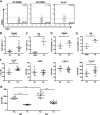A critical epitope in CD147 facilitates memory CD4+ T-cell hyper-activation in rheumatoid arthritis
- PMID: 29563614
- PMCID: PMC6804595
- DOI: 10.1038/s41423-018-0012-4
A critical epitope in CD147 facilitates memory CD4+ T-cell hyper-activation in rheumatoid arthritis
Abstract
The abnormal activation of CD4+CD45RO+ memory T (Tm) cells plays an important role in the pathogenesis of rheumatoid arthritis (RA). Previous studies have shown that CD147 participates in T-cell activation. However, it remains unclear whether CD147 is involved in abnormal Tm-cell activation in RA patients. In this study, we demonstrated that CD147 was predominantly upregulated in Tm cells derived from RA patients. The anti-CD147 mAb 5A12 specifically inhibited Tm-cell activation and proliferation and further restrained osteoclastogenesis. Using a structural-functional approach, we depicted the interface between 5A12 and CD147. This allowed us to identify two critical residues, Lys63 and Asp65, as potential targets for RA treatment, as the double mutation K63A/D65A inhibited Tm-cell activation, mimicking the neutralization by 5A12. This study provides not only a theoretical basis for a "CD147-Tm/Osteoclast-RA chain" for the potential prevention and treatment of RA or other T-cell-mediated autoimmune diseases but also a new target for related drug design and development.
Keywords: CD147; CD4+ Memory T cell; Immunotherapy; Monoclonal Antibody; Rheumatoid arthritis.
Conflict of interest statement
The authors declare no competing interests.
Figures






Similar articles
-
CD147 Expressed on Memory CD4+ T Cells Limits Th17 Responses in Patients With Rheumatoid Arthritis.Front Immunol. 2020 Oct 28;11:545980. doi: 10.3389/fimmu.2020.545980. eCollection 2020. Front Immunol. 2020. PMID: 33193313 Free PMC article.
-
CD147-mediated chemotaxis of CD4+CD161+ T cells may contribute to local inflammation in rheumatoid arthritis.Clin Rheumatol. 2018 Jan;37(1):59-66. doi: 10.1007/s10067-017-3800-9. Epub 2017 Sep 25. Clin Rheumatol. 2018. PMID: 28948414
-
Involvement of HAb18G/CD147 in T cell activation and immunological synapse formation.J Cell Mol Med. 2010 Aug;14(8):2132-43. doi: 10.1111/j.1582-4934.2010.01012.x. Epub 2010 Jul 15. J Cell Mol Med. 2010. PMID: 20082657 Free PMC article.
-
Mesenchymal Stem Cells Improve Rheumatoid Arthritis Progression by Controlling Memory T Cell Response.Front Immunol. 2019 Apr 16;10:798. doi: 10.3389/fimmu.2019.00798. eCollection 2019. Front Immunol. 2019. PMID: 31040848 Free PMC article. Review.
-
Cyclophilin-CD147 interactions: a new target for anti-inflammatory therapeutics.Clin Exp Immunol. 2010 Jun;160(3):305-17. doi: 10.1111/j.1365-2249.2010.04115.x. Epub 2010 Mar 16. Clin Exp Immunol. 2010. PMID: 20345978 Free PMC article. Review.
Cited by
-
Soluble CD147 regulates endostatin via its effects on the activities of MMP-9 and secreted proteasome 20S.Front Immunol. 2024 Jan 22;15:1319939. doi: 10.3389/fimmu.2024.1319939. eCollection 2024. Front Immunol. 2024. PMID: 38318187 Free PMC article.
-
Intervention with extracellular matrix metalloproteinase inducer in osteoclasts attenuates periodontitis-induced bone resorption.Odontology. 2024 Jan;112(1):148-157. doi: 10.1007/s10266-023-00819-8. Epub 2023 May 25. Odontology. 2024. PMID: 37227552
-
Microbial short-chain fatty acids: a strategy to tune adoptive T cell therapy.J Immunother Cancer. 2022 Jul;10(7):e004147. doi: 10.1136/jitc-2021-004147. J Immunother Cancer. 2022. PMID: 35882448 Free PMC article. Review.
-
ACPA-CD147 axis in the NLRP3 inflammasome of RA macrophages.Cell Mol Immunol. 2022 Aug;19(8):957-959. doi: 10.1038/s41423-022-00889-8. Epub 2022 Jun 22. Cell Mol Immunol. 2022. PMID: 35729222 Free PMC article. No abstract available.
-
Identification of human immune cell subtypes most responsive to IL-1β-induced inflammatory signaling using mass cytometry.Sci Signal. 2021 Mar 9;14(673):eabc5763. doi: 10.1126/scisignal.abc5763. Sci Signal. 2021. PMID: 33688079 Free PMC article.
References
Publication types
MeSH terms
Substances
LinkOut - more resources
Full Text Sources
Other Literature Sources
Medical
Research Materials

